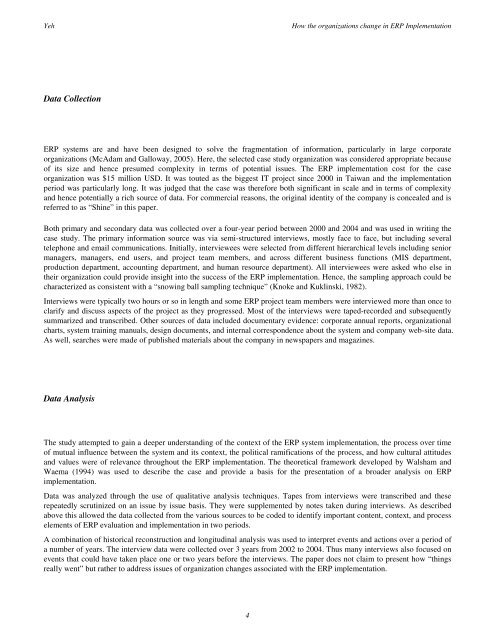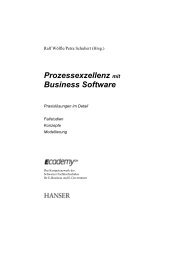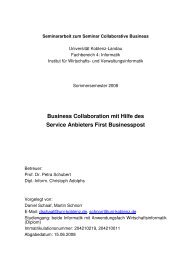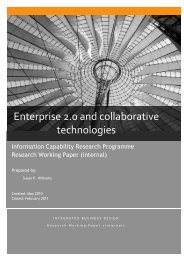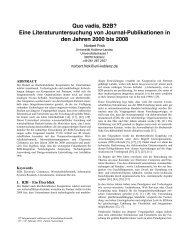HOW THE ORGANIZATIONS CHANGE IN ERP IMPLEMENTATION
HOW THE ORGANIZATIONS CHANGE IN ERP IMPLEMENTATION
HOW THE ORGANIZATIONS CHANGE IN ERP IMPLEMENTATION
Create successful ePaper yourself
Turn your PDF publications into a flip-book with our unique Google optimized e-Paper software.
YehHow the organizations change in <strong>ERP</strong> ImplementationData Collection<strong>ERP</strong> systems are and have been designed to solve the fragmentation of information, particularly in large corporateorganizations (McAdam and Galloway, 2005). Here, the selected case study organization was considered appropriate becauseof its size and hence presumed complexity in terms of potential issues. The <strong>ERP</strong> implementation cost for the caseorganization was $15 million USD. It was touted as the biggest IT project since 2000 in Taiwan and the implementationperiod was particularly long. It was judged that the case was therefore both significant in scale and in terms of complexityand hence potentially a rich source of data. For commercial reasons, the original identity of the company is concealed and isreferred to as “Shine” in this paper.Both primary and secondary data was collected over a four-year period between 2000 and 2004 and was used in writing thecase study. The primary information source was via semi-structured interviews, mostly face to face, but including severaltelephone and email communications. Initially, interviewees were selected from different hierarchical levels including seniormanagers, managers, end users, and project team members, and across different business functions (MIS department,production department, accounting department, and human resource department). All interviewees were asked who else intheir organization could provide insight into the success of the <strong>ERP</strong> implementation. Hence, the sampling approach could becharacterized as consistent with a “snowing ball sampling technique” (Knoke and Kuklinski, 1982).Interviews were typically two hours or so in length and some <strong>ERP</strong> project team members were interviewed more than once toclarify and discuss aspects of the project as they progressed. Most of the interviews were taped-recorded and subsequentlysummarized and transcribed. Other sources of data included documentary evidence: corporate annual reports, organizationalcharts, system training manuals, design documents, and internal correspondence about the system and company web-site data.As well, searches were made of published materials about the company in newspapers and magazines.Data AnalysisThe study attempted to gain a deeper understanding of the context of the <strong>ERP</strong> system implementation, the process over timeof mutual influence between the system and its context, the political ramifications of the process, and how cultural attitudesand values were of relevance throughout the <strong>ERP</strong> implementation. The theoretical framework developed by Walsham andWaema (1994) was used to describe the case and provide a basis for the presentation of a broader analysis on <strong>ERP</strong>implementation.Data was analyzed through the use of qualitative analysis techniques. Tapes from interviews were transcribed and theserepeatedly scrutinized on an issue by issue basis. They were supplemented by notes taken during interviews. As describedabove this allowed the data collected from the various sources to be coded to identify important content, context, and processelements of <strong>ERP</strong> evaluation and implementation in two periods.A combination of historical reconstruction and longitudinal analysis was used to interpret events and actions over a period ofa number of years. The interview data were collected over 3 years from 2002 to 2004. Thus many interviews also focused onevents that could have taken place one or two years before the interviews. The paper does not claim to present how “thingsreally went” but rather to address issues of organization changes associated with the <strong>ERP</strong> implementation.4


